Dezinfekce vzduchu pomocí UV-C záření jako opatření proti šíření nákazy Covid
23.11.2020
Naši klienti nás v poslední době žádají o rady ohledně opatření proti šíření nákazy Covid včetně dezinfekce vzduchu pomocí UV-C záření. Připravili jsme pro Vás stručný přehled (v angličtině) UV-C technologií a jejich použití s využitím znalostí publikovaných ASHRAE. Máte-li jakékoli otázky ohledně anti-Covid opatření v systémech vzduchotechniky, vytápění a chlazení, neváhejte požádat OPTIMAL o konzultaci.
Ultraviolet Energy (UV-C)
- Ultraviolet energy inactivates viral, bacterial, and fungal organisms so they are unable to replicate and potentially cause disease.
- The entire UV spectrum is capable of inactivating microorganisms, but UV-C energy (wavelengths of 100 – 280 nm) provides the most germicidal effect, with 265 nm being the optimum wavelength.
- The majority of modern UVGI lamps create UV-C energy with an electrical discharge through a low-pressure gas (including mercury vapor) enclosed in a quartz tube, similar to fluorescent lamps.
- Roughly 95% of the energy produced by these lamps is radiated at a near-optimal wavelength of 253.7 nm.
- UV-C light-emitting diodes (LEDs) are emerging for use.
- Types of disinfection systems using UV-C energy:
- In-duct air disinfection
- Upper-air disinfection
- In-duct surface disinfection
- Portable room decontamination
- Requires special PPE to prevent damage to eyes and/or skin from overexposure.
- The Illuminating Engineering Society (IES) Photobiology Committee published a FAQ on Germicidal Ultraviolet (GUV) specific to the COVID-19 pandemic.
For more information, see the ASHRAE Position Document on Filtration and Air Cleaning.
UV-C LEDs
- Have been common in the UV-A spectrum (315 – 400 nm)
- LEDs are starting to be produced in the 265 nm range
- Efficiency is dramatically less than current low-pressure mercury vapor lamps
- Minimal UV output compared to a low-pressure mercury vapor lamp
- For equal output, UV-C LEDs are more expensive than current low-pressure mercury vapor lamps
- Limited availability; not yet practical for commercial HVAC applications
For more information, see the FAQ on Germicidal Ultraviolet (GUV) published by the Illuminating Engineering Society (IES) Photobiology Committee.
UV-C In-Duct Air Disinfection
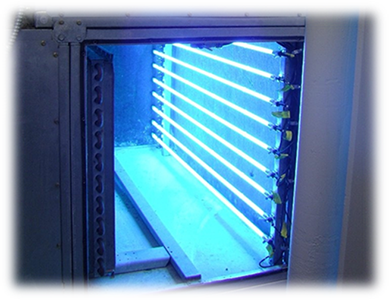
- Banks of UV-Lamps installed inside HVAC systems or associated ductwork.
- Requires high UV doses to inactivate microorganisms on-the-fly as they pass through the irradiated zone due to limited exposure time.
- Minimum target UV dose of 1,500 µW•s/cm2 (1,500 µJ/cm2)
- Systems typically designed for 500 fpm moving airstream.
- Minimum irradiance zone of two feet
- Minimum UV exposure time of 0.25 second.
- Should always be coupled with mechanical filtration.
- MERV 8 filter for dust control
- Highest practical MERV filter recommended
- Enhanced overall air cleaning with increased filter efficiency
UV-C Upper-Air Disinfection
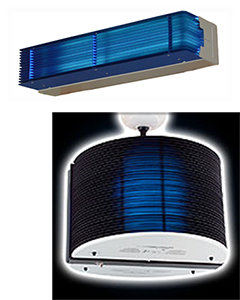
- UV fixtures mounted in occupied spaces at heights of 7 feet and above.
- Consider when:
- No mechanical ventilation
- Limited mechanical ventilation
- Congregate settings and other high-risk areas
- Economics/other
- Requires low UV-reflectivity of walls and ceilings
- Ventilation should maximize air mixing
- Use supplemental fans where ventilation is insufficient
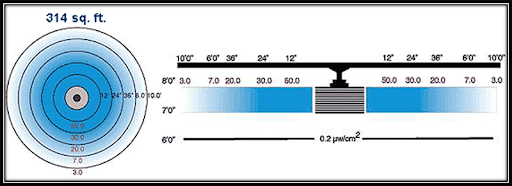
UV-C In-Duct Surface Disinfection
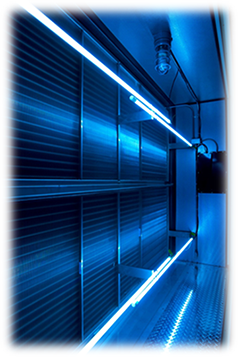
- Banks of UV-Lamps installed inside HVAC systems, generally focused on:
- Cooling coils
- Drain pans
- Other wetted surfaces
- UV irradiance can be lower than in-duct air disinfection systems due to long exposure times.
- Goals are:
- Even distribution of UV energy across the coil face
- Generally, 12 to 36 inches from the coil face
- Operated 24/7
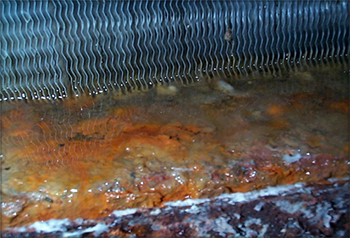
UV-C Portable Room Decontamination
- For surface decontamination
- Portable, fully automated units; may use UV-C lamps or Pulsed Xenon technology
- Settings for specific pathogens such as MRSA, C. difficile, both of which are harder to inactivate than coronaviruses.
- >99.9% reduction of vegetative bacteria within 15 minutes
- 99.8% for C.difficile spores within 50 minutes
(Rutala et al. 2010)
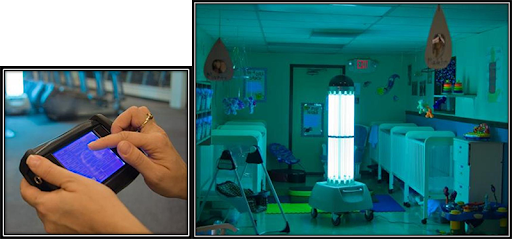

Novinky
- 29.6.2022 Certifikace LEED Platinum a WELL HS rating pro novou význačnou administrativní budovu ve Varšavě
- 23.11.2020 Dezinfekce vzduchu pomocí UV-C záření jako opatření proti šíření nákazy Covid
- 25.7.2019 Retro-Commissioning – proces pro zlepšení funkce TZB systémů v budovách
- 25.7.2019 Zaměstnanci jsou šťastnější, zdravější a více produktivní v LEED certifikovaných budovách
- 25.7.2019 LEED Platinum certifikace pro dvě nové budovy na Pankráci v Praze
- 25.7.2019 Šárecký dvůr nejlepším rezidenčním projektem
- 17.5.2018 TRIMARAN na pražské Pankráci vyplouvá
- 11.4.2018 Centrum firmy Era v Pardubicích

Novinky
- 29.6.2022 Certifikace LEED Platinum a WELL HS rating pro novou význačnou administrativní budovu ve Varšavě
- 23.11.2020 Dezinfekce vzduchu pomocí UV-C záření jako opatření proti šíření nákazy Covid
- 25.7.2019 Retro-Commissioning – proces pro zlepšení funkce TZB systémů v budovách
- 25.7.2019 Zaměstnanci jsou šťastnější, zdravější a více produktivní v LEED certifikovaných budovách
- 25.7.2019 LEED Platinum certifikace pro dvě nové budovy na Pankráci v Praze
- 25.7.2019 Šárecký dvůr nejlepším rezidenčním projektem
- 17.5.2018 TRIMARAN na pražské Pankráci vyplouvá
- 11.4.2018 Centrum firmy Era v Pardubicích










